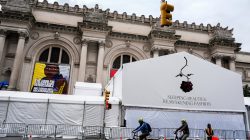The popular district of Kichijoji, in western Tokyo, is the place to hunt for vintage clothes and quirky antiques, enjoy drinks and food in the narrow alleyways called Harmonica Yokocho, or ride the swan boats in scenic Inokashira Park.
Right at home in this buzzy area is a shop called Masa’s Pastime, specializing in antique pocket watches and repairs. But its founder and president, Masa Nakajima, has turned the business into more than a pastime over the years.
And this spring he plans to introduce two iterations of an original watch — not yet named — that he created with his team of watchmakers, most of whom are recent graduates of the Hiko Mizuno College of Jewelry.
Masa’s Pastime does a lot of things. “We sell antique watches, mostly pocket watches that are around 300 years old, and custom-made watches we made using the antique movements from pocket watches and creating a new case, dial and hands,” Mr. Nakajima said, displaying a wristwatch with a black carbon-coated steel case (1.1 million yen, or $7,455). It was powered with a 100-year-old Hamilton pocket watch movement, he said, noting, “those old pocket watch movements were not only of good quality and beautifully finished, but also durable.”
His workers also do repairs (walk-ins are welcome), special commissions (for example, customers can have the movement of an antique pocket watch put into an original case created in the shop), and customizations such as engraving or blued screws, a decorative element in movements.
On a sunny and crisp December day, I met Mr. Nakajima, 60, and his eight employees at the shop, which has the warm, welcoming feel of walking into someone’s living room.
Mr. Nakajima’s first encounter with antique watches was in the 1980s in Los Angeles, where he lived and studied for a few years. “That’s where I met a Japanese guy who was purchasing antique watches at a flea market and selling them to retailers,” he said. “I helped him every Sunday.”
By 1990, back in Japan, he opened Masa’s Junkyard, a small space in his hometown, Higashimurayama, just outside Tokyo. “The shop was literally a junkyard,” he said. “Antique stuff. A lot of junk from America,” he said. But, “we increasingly had customers who wanted watches, so we started to focus on those.”
After encountering problems with some repair work, Mr. Nakajima decided in 1993 that he had to start doing it himself: “It wasn’t that I really wanted to do it or felt passionate about it, but there was a need for me to become a repairman.”
He bought some instructional books, then was joined by Katsuhisa Iwata, a carpenter turned watchmaker, who still works at Masa’s Pastime today. The store moved a couple of times, but finally ended up in its current location.
The store and workroom, covering nearly 1,780 square feet, now include glass cases housing the antique pocket watches for sale (recently, a 1891 Patek Philippe model was priced at ¥2 million) and two watchmakers’ benches by the large front window. “We also sell plates and cutlery,” Mr. Nakajima said as he pointed at some silverware displayed near the entrance, “leftovers from Masa’s Junkyard.”
The business is open every week from Tuesday to Saturday, and after it closes at 8 p.m., Mr. Nakajima likes to stop for a drink in Harmonica Yokocho before heading home. He also likes to fish on Sundays.
He has two daughters, ages 18 and 23, but “none of them are interested in watches,” he said. He thinks the staff probably will take over the business when he decides to retire. “I’m more interested in the managing side now, and developing the original watch with my team,” he said. “I do what I enjoy.”
A Japanese Touch
Mr. Nakajima and the team began working on their own watch several years ago and had teamed up with Fabian Pellet, a Swiss watchmaker based in Japan, to design its movement.
But then Philippe Dufour, the celebrated Swiss independent watchmaker who is particularly loved in Japan, came to visit in 2015. “I showed him our movement, and he liked it,” Mr. Nakajima said. “But he said, ‘This is just a great Swiss watch, but there is no Japanese touch.’”
Mr. Nakajima returned to the project only a couple of years ago. But Mr. Iwata, 49, now has made all the parts and the rest of the team has been doing the finishing and engraving. “It’s 100 percent made in Japan, with our in-house movement, except for the rubies and the mainspring and hairspring,” Mr. Nakajima said, noting that that is rare in Japan, as most independent watchmakers either buy parts or have them made.
Is the watch now Japanese? “I don’t really think it looks Japanese,” he said, “but at least it looks original.”
He displayed a test version of the in-house movement, called the MP1, which will be used in the two iterations of the 37.5-millimeter watch scheduled to go on sale in April through the company’s website. And by April 2025 he intends to have completed eight more watches, for a total of five of each version.
One model will have an 18-karat gold case and hands, with a blackened dial made of a copper alloy called shakudo. The dials are being created by Kei Tsujimoto, 40, an engraver who works at one of the benches near the shop’s front window. (“Sometimes children stop and watch me work,” he said).
The other will have a sterling silver dial and polished silver hands.
Prices have not yet been determined, but all the watches will come with leather straps from the French company Jean Rousseau.
About Teamwork
It was 2018, Mr. Nakajima said, when he started hiring Mizuno graduates through the school’s job-finding program.
One of his hires was Nayuta Shinohara, 29, who won the 2020 Walter Lange Watchmaking Excellence Award in an annual contest organized by the German brand A. Lange & Söhne. The next year Mr. Nakajima read about the young watchmaker’s achievements in a magazine and, a week later, Mr. Shinohara called, looking for a job. “I hired him immediately,” Mr. Nakajima said.
Mr. Shinohara also has created his own 38.6-millimeter watch, the Nayuta, inspired by a pocket watch. He has been working on six copies of what he calls its Model A, a sterling silver style with a dial that Mr. Tsujimoto guillochéd and engraved by hand (¥5.5 million), and two copies of Model B, also in silver (¥2.7 million). The Nayuta models are on sale at Masa’s Pastime.
The team also includes Alexandre Cusenier, 34, a watchmaker from Besançon, France, who recently moved to Japan. After graduating from his hometown’s watchmaking school, he worked independently for 10 years and then as a decorator in a watch atelier in Switzerland’s Vallée de Joux. But, having visited Japan as a tourist several times over the years, a chain of coincidences brought him back in September.
He has enrolled in a Japanese language school and comes to Masa’s Pastime after school. “On Saturdays I can come whenever I feel like it, but I usually come because I enjoy being here,” he said.
Has he noticed any cultural differences between Swiss and Japanese ateliers? “They’re very demanding here,” he said. “Sometimes I’m asked if I can do better, so I have to redo it. As I work here, I’m upgrading the quality of my work and making progress.”
“I think the spirit of Masa’s Pastime is very similar to that of 50 years ago, when the emphasis was on quality,” he said.
Mr. Nakajima said that he had not noticed any drastic cultural differences between the way that Swiss and Japanese watchmakers work, but that the Swiss are “faster than us.”
“Also, we tend to do everything by hand, and they use more electric motors,” he said. “At first, I wasn’t sure it was OK to use those on delicate watch parts, but I saw it doesn’t damage them. Now the other guys are trying to imitate his way now, so we all learn from each other.”
Masa’s Pastime is a place where the recent graduates can nurture and develop their skills, Mr. Nakajima said: “I teach them how to repair antique watches, but other than that, they were pretty much educated at school. And they will learn by themselves.
“I just tell them not to break the customers’ watches!”
Sumber: www.nytimes.com










